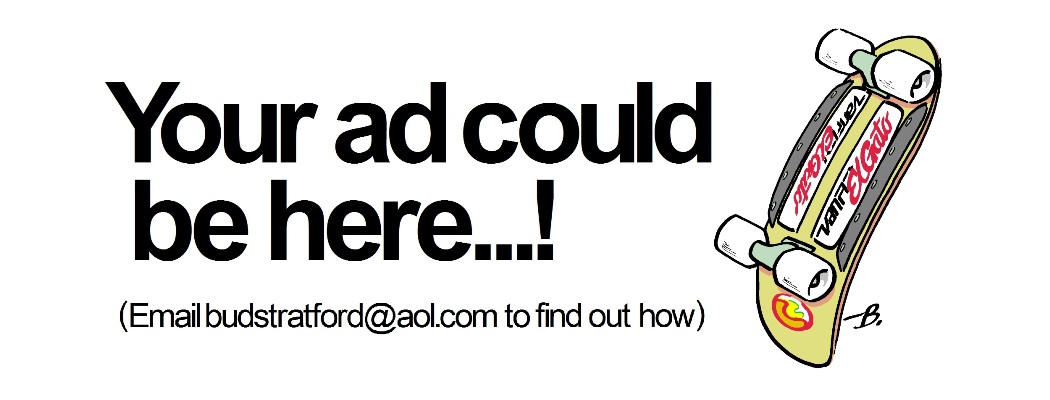

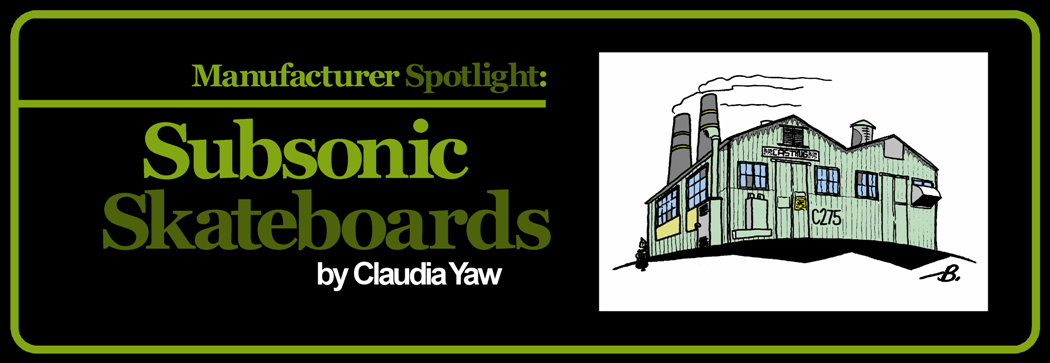
Manufacturer Spotlight:
Subsonic Skateboards
by Claudia Yaw
When original owner Scott Moore opened Subsonic Skateboards in 1999, he handcrafted every board. From start to finish, Moore would design, stain, press, cure, cut, sand, and polish every deck. But the growing popularity of Subsonic boards created a demand that Moore simply couldn’t keep up with. So in 2015, four more owners bought into the company, moving it from Portland, OR to its current location in Southern Seattle.
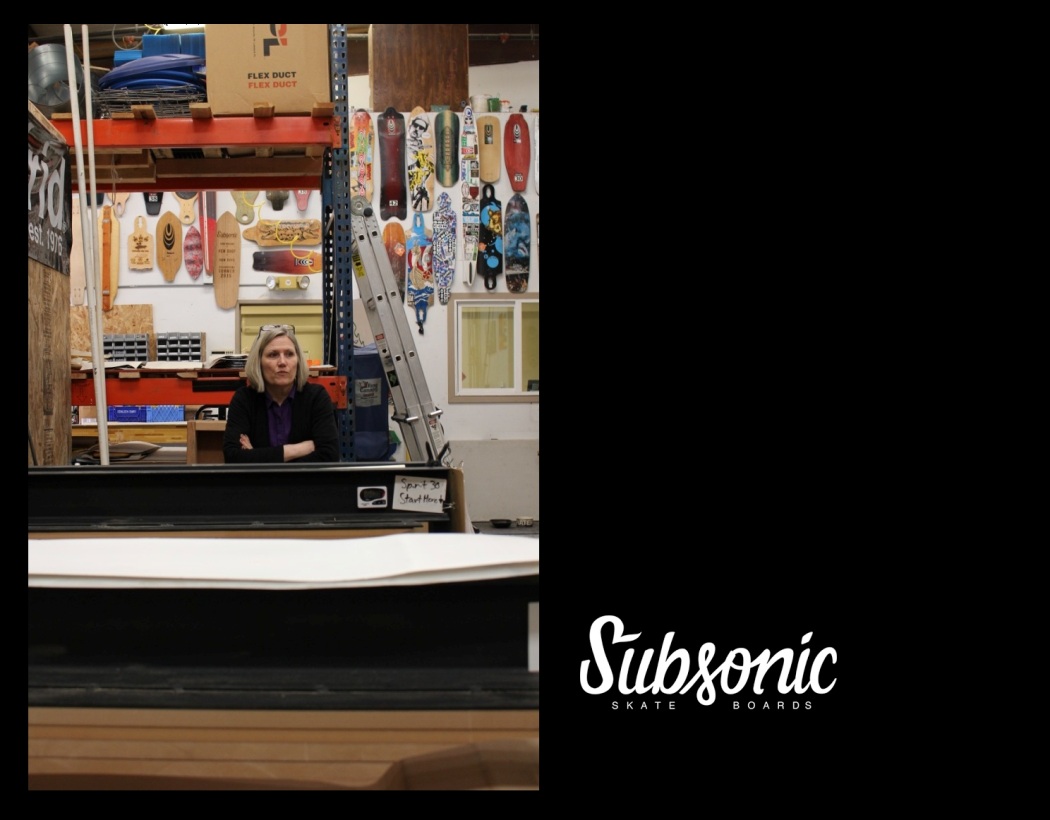
Left: Owner Anne Cameron, overlooking the gluing process at Subsonic’s manufacturing facility. Right: Subsonic’s trademark.
I met Anne and her husband last month at Trader Joe’s, where I work. Between bagging organic dog food and fair trade goat milk, I told them about the rad skate magazine I intern for. They gave me some sick Subsonic stickers and told me to contact them if EverythingSkateboarding wanted to do a feature on a Seattle-based custom shop.
Subsonic currently has five owners, but the fellow most involved with the design and craftsmanship is Ryan Villa. Ryan studied engineering, but left school when given the opportunity to design and engineer skateboards at Subsonic. The young longboarder is largely responsible for the creation of the boards, and was more than excited to show me every step of the process.
The boards start as thin sheets of wood which are squeezed together with a hydraulic press. Ryan explained that although each mold corresponds to a specific board produced by Subsonic, they aren’t exact replicas, since the boards, once pressed, relax into their final shape.
![]()

Left and right: Quality in, quality out; Ryan shows off the veneer.
The planks of wood pressed together are meticulously chosen according to their grain. Depending on which way the grain runs, the wood will flex wither lengthwise or widthwise. Stacking these sheets of wood differently will therefore produce different levels of flexibility in a board. After being pressed, the wood sits in a curing room set to 73 degrees and 37% humidity to allow the boards to settle into their final shapes.
The coolest step in creating a Subsonic longboard is the CNC machine, or Computer Numeric Control machine. Ryan informed me that the huge piece of machinery is named Betty, and that “she’s big and she’s loud and she’s awesome.” Betty sits in a room largely filled with sawdust and fiberglass. The massive contraption is responsible for cutting the boards out according to digital instructions given by Ryan. Anne described how complicated the software program is that Ryan uses. “I had to go to North Carolina to get training for this specific program,” he told me. “I’m a pretty fast learner, so once I figured out the basics, I just started making things.”
“Her name is Betty. She’s big, and she’s loud, and she’s awesome.”
-Ryan Villa
![]()

Betty, Subsonic’s Computer Numeric Control machine, is responsible for cutting each longboard out.
Drew, Subsonic’s intern, described how the sawdust is kept in huge bins which have to be systematically emptied- one of the less enjoyable tasks at Subsonic.“I was in full layers and I was still itching the day after.” Betty uses different drill bits to create the main shape for the longboards, as well as the smaller details.
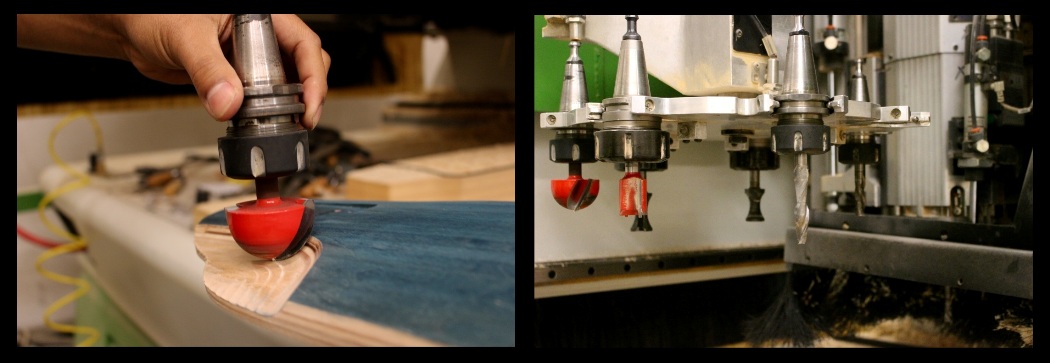
Ryan demonstrates how a round drill bit creates a detailed cut in one of the boards.
“Even though a lot’s done on the machine, we still spend a lot of time hand shaping each board,” Ryan explained. In fact, every board is hand sanded after going through the CNC machine.
“Even though a lot’s done on the machine, we still spend a lot of time hand shaping each board.”
-Ryan Villa
The sanding process is where a lot of the craftsmanship comes in. On a Subsonic board, every curve and edge has a purpose, and is carefully sanded by hand. Ryan uses tools he makes himself to make sure every detail on each longboard is just right. When asked about other skate companies, Ryan and Anne both described how Subsonic’s level of detail is pretty unique in the industry. Ryan pointed to companies that manufacture their boards overseas. “To them it’s about the money and not about how it feels.”
Subsonic boards are sanded and shaped with tools custom made to fit the nooks and crannies of every unique board.
Each Subsonic board is also hand stained, making even the standard boards inherently unique. Anne admits that the staining process is pretty therapeutic. “If you’re staining the wood you can just listen to music or a book on tape.” Drew claimed that he once stained planks of wood for three hours before realizing how much time had passed.Ryan and Drew make rings, medals, and tools out of scrap wood left over from the CNC machine.
The final step is giving the longboards a graphic. Graphics are commissioned from artists outside the company, and range from more simple and abstract designs to elaborate animals, skulls, or even pirates. Most graphics are screen printed onto the longboards, but Subsonic also laser cuts some of their designs onto decks to create more scratch-resistant graphics. After graphics are added, each board undergoes a clear coating process. Between each coat, boards have to completely buffed in order to achieve the perfect glossy finish.
![]()

Top left: Laser cut graphic. Bottom left: Screen printing screen. Right: Graphic by Subsonic artist.
The finished boards are glossy, rad, and built to last. Ryan pointed out that shorter boards often only last a few months, or until street skaters get slammed and break their boards in half. “Especially with the crazy things street skaters do,” he claimed, “like throwing themselves down ten stairs.” He described a cycle between companies, who pump out low-quality boards, and skaters, who expect their boards to snap. Subsonic intentionally makes their longboards to last. Anne emphasized this point, and talked about a return customer: “We had a guy whose last order was in 2012, and the only reason he came back was because a car ran over his last one.”
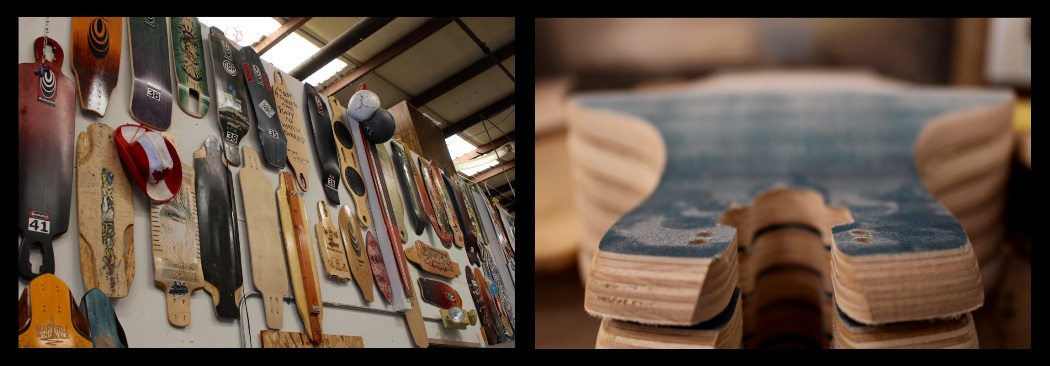
Left: “The Graveyard,” a wall of broken, discontinued, and experimental boards. Right: A stack of decks, fresh out of the CNC machine.
Subsonic’s youtube page features recaps and features of their downhill team, who explore beautiful PNW sights while ripping down hills at upwards of 40 miles an hour. This might be the biggest difference between street/vert skating and downhill: the scenery. Ryan described a recent skating trip in Canada, where the hill him and his friends were riding down overlooked the some islands off the coast.
“You’re thinking, man this is awesome. The scene itself just encapsulates you…and then you’re like, oh! I should pay attention to what I’m doing!”
-Ryan Villa
The epic scenery of the Pacific Northwest may also be why downhill is so popular here. Ryan grew up in the desert of Tri-Cities in Southeast Washington, and remembers the longboarding scene consisting of no more than seven kids. His love for longboarding and downhill is what led him to Seattle: “I was like, I need to go somewhere where my people are.”
![]()

Left: Unique skate trophies for Maryhill racing. Right: A medal made by Ryan for downhill race Push in the Woods
Anne’s son is a downhill skater, and although she claims her skating abilities stop at balancing on a board, she knows first hand how welcoming the community is. “They’re just so inclusive. It’s like, ‘just wear your helmet and come skate with us!’” Although downhill skating is objectively terrifying (maybe it’s just me), Anne described how longboarding is incredibly diverse. Sure, there are downhill racers like Ryan, who get on a board in a full leather suit, ready to whip around hairpin turns at the speed of light. But there’s also pushers and pumpers, cruisers, and long distance guys like Andrew Andras. Andras holds the world record for the farthest distance traveled on a skateboard in 24 hours: 309 miles!
“They’re just so inclusive. It’s like, ‘just wear your helmet and come skate with us!’”
-Anne Cameron
This year, Subsonic designed “La Maquina,” a red carbon platform board with metal brackets, especially for Andras. Subsonic also sees their fair share of older riders. “We’ll regularly sell customs to guys in their 60s and 70s,” Anne told me. “This is a sport you can do all your life.” Anne in particular is very proud of the diversity that Subsonic caters to. “I think it just goes to show that there isn’t just one kind of skater. There’s no stereotype that fits all skaters.”
“I think it just goes to show that there isn’t just one kind of skater. There’s no stereotype that fits all skaters.”
-Anne Cameron
![]()

Left: Intern Drew holding a personal project that met its demise. Right: A platform board prototype with metal brackets.
Subsonic is proud to manufacture all of their boards in the States. In regards to the current state of skateboarding, Subsonic’s owners know that more and more companies are becoming corporatized, shipping manufacturing overseas, and mindlessly pumping out boards. Ryan is optimistic, though, that Subsonic and other small custom shops will be able to stay afloat.
“At the end of the day, people are going to recognize quality.”
-Ryan Villa
![]()
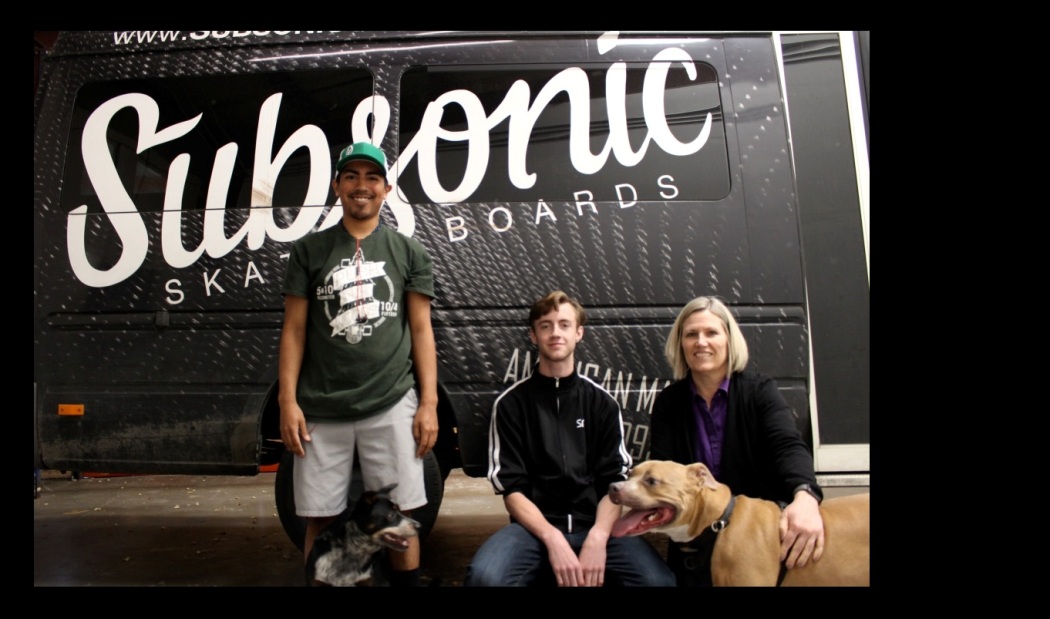
Ryan, Drew, Anne, Penelope, and Cooper pose in front of the Subsonic van.
![]()

